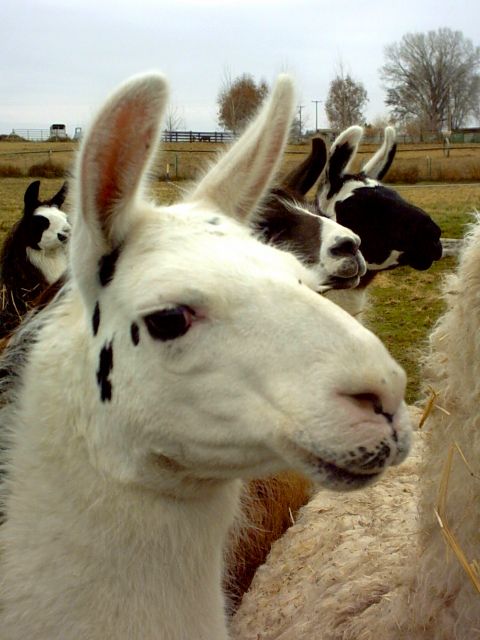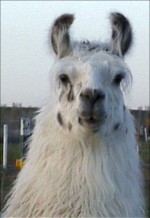|


| |
2005
Llama lovers cite numerous reasons for having llamas around. These reasons
include their calm and serene nature, their inquisitiveness, their willingness
to work as packers and guards, their relatively low maintenance requirements,
and their remarkable intelligence. The latter reason has been a subject of considerable
rumination on my part, as I’ve closely observed llama behavior over the past
couple of years. It's long been a point of speculation as to how much of
animal makeup is innate instinct vs. learned behavior vs. abstract cognition
(awareness of things not currently perceived and thinking ahead to potential
consequences).
Llamas are often compared to other animals in terms of relative intelligence,
usually in regards to how quickly they learn. A renown trainer of both horses
and llamas reports that he can teach an average llama something in an hour what
takes the average horse three days to learn, a trait often corroborated
elsewhere. In addition, the llama never forgets,
whereas the horse needs refresher training if a long period of
inactivity goes by. In this regard, llamas are considered more akin to dogs than
horses (though it's a real challenge to even teach a dog anything in an hour). Like dogs, llamas are also very social creatures, though for very
different reasons. Generally speaking, animals that fall into the prey category
(eyes on the side of the head) survive by eluding predators. A charging wildcat
would have an easy time of it if the members of a herd crashed into one another
and knocked each other down trying to flee. Instead, they appear
to move in one fluid motion. This is because each member, based on their
position in the hierarchy, knows who they yield to and who yields to them. Order
is key to survival. Though the need for a hierarchical social structure comes
naturally and the principle of personal space is very deliberately taught by the
adults to the youngsters, llamas haven’t
had to contend with many large predators in their natural environment. It's
their young that are most vulnerable to bobcats and foxes. Possibly
as a result, they have developed a much more assertive nature than your typical
prey animal, known to actually kill coyotes threatening the young, and the hierarchy seems to be somewhat more fluid, being repeatedly
tested, challenged and reinforced – particularly as herd size increases.
 We
have a dozen female llamas that run together in the large pastures, along with
two intact males in separate smaller adjoining fields. Our kitchen window
provides a clear view of most of this area and is more entertaining than TV. The
ongoing llama drama observed from this window rivals that of the daytime soaps.
We observed that among the female herd, while various relationships waxed and
waned, one thing remained constant throughout: That being, one particular gal was
always #1.
Her name is Dazy-May, and is pictured to the right in the
foreground. The other girls would look to her, to follow her
lead, and would always yield to her. Yet, unlike the others Dazy was never
involved in overt conflict, jostling for position. Her most overt act was a
look, and maybe a dry spit, whereas some of the other girls got into real
knock-down, drag-outs from time to time – screaming, wrestling and chest butting like the males. So I
began to wonder, what was it about her that everyone respected? We
have a dozen female llamas that run together in the large pastures, along with
two intact males in separate smaller adjoining fields. Our kitchen window
provides a clear view of most of this area and is more entertaining than TV. The
ongoing llama drama observed from this window rivals that of the daytime soaps.
We observed that among the female herd, while various relationships waxed and
waned, one thing remained constant throughout: That being, one particular gal was
always #1.
Her name is Dazy-May, and is pictured to the right in the
foreground. The other girls would look to her, to follow her
lead, and would always yield to her. Yet, unlike the others Dazy was never
involved in overt conflict, jostling for position. Her most overt act was a
look, and maybe a dry spit, whereas some of the other girls got into real
knock-down, drag-outs from time to time – screaming, wrestling and chest butting like the males. So I
began to wonder, what was it about her that everyone respected?
The most “obvious” reason for respect in the animal kingdom would be that she
was clearly the biggest and strongest, able to fend off all challengers,
combined with a very assertive personality. While applicable to the males,
this didn’t apply to the females as Dazy is
one of the smallest and lightest llamas in the herd – some being nearly double
her weight. Also, as noted previously, she never seemed to be involved in fights
and didn’t exhibit aggressive behavior towards anyone else. She instead seemed
rather aloof, doing whatever she pleased while others followed. Scratch the
"brawn" theory.
Okay... at 15+ years of age she happens to be the oldest, with a
daughter and
granddaughter in the herd – thereby acquiring
the nickname of “Granny-May”. This is a unique characteristic that sets her
apart. However, aside from the possible exception of her daughter, it doesn’t
seem probable that the others would have any real awareness or respect for her
age alone. Neither would it be due to her “getting to the top first”, as “new”
adult llamas have come and gone from the herd, shaking up the hierarchy, yet
none have overtly challenged her. The "respect your elder" theory dropped off the list, and I was quickly running out of theories.
Months went by and it remained a mystery.
The reason finally became strikingly apparent one morning during feeding time
when Dazy revealed her true colors. Each
morning, all the llamas would receive their tasty vitamin/mineral supplement
ration in a string of small buckets hanging from the fence inside the feeding/holding pens.
This would result in a game of musical buckets, as each girl would take
ownership of a bucket, jostling for position, pushing each other around based on
the pecking order. One bucket happened to be hung on the common field fence
separating the females from one of our intact males. His name is
Santana, and is pictured below. Santana is a real
mellow, easy-going, soft-spoken guy, but isn’t
averse to figuring out a way to get what he wants even if it means cheating.
 Once
Santana finished his ration, he developed a practice of each day poking his nose
through a hole in the common field fence. With some effort, he could feel around with
those dexterous lips, grab hold of the rim of the bucket, and flick it such that
the bucket would turn with the top facing the fence. He would then stick his
nose sideways through another fence hole and steal the remaining goodies from
within. Whichever girl happened to be at that bucket at the time would pull
their head back, nose in the air in protest, watching him do this, then grunt in disgust
and go jostle for a new bucket. Perhaps because he was the male, no one would
challenge this intrusion. Consequently, he continued to be rewarded
for his efforts and it became a matter of routine. This went on for weeks...
until, that is, he tried it for the first time with Dazy at this bucket. Once
Santana finished his ration, he developed a practice of each day poking his nose
through a hole in the common field fence. With some effort, he could feel around with
those dexterous lips, grab hold of the rim of the bucket, and flick it such that
the bucket would turn with the top facing the fence. He would then stick his
nose sideways through another fence hole and steal the remaining goodies from
within. Whichever girl happened to be at that bucket at the time would pull
their head back, nose in the air in protest, watching him do this, then grunt in disgust
and go jostle for a new bucket. Perhaps because he was the male, no one would
challenge this intrusion. Consequently, he continued to be rewarded
for his efforts and it became a matter of routine. This went on for weeks...
until, that is, he tried it for the first time with Dazy at this bucket.
Dazy was calmly feeding when a snout slips through the fence, lips
reaching for the bucket. As with the
other girls, she yanked her head back, nose stabbing the air and ears back protesting this
unwelcome incursion, which Santana paid no heed to. But instead of
leaving, she stood there watching Santana for a moment as he struggled to get
hold of the bucket. Then, calmly, she turned around in place, doing a complete
180° rotation. Spreading her hind feet and assuming “the position”, she
proceeded to unleash a prodigious stream of urine, squarely into the center of the bucket. She did this
looking straight ahead, nose slightly elevated, like, “laa-tee-daa...”.
Santana, feet rooted to the ground, jerked his head back as far as it would go,
body recoiled in horror! Those of you familiar with llamas know that
they are quite fastidious about cleanliness. They establish a community
potty-pile, separate from anywhere they eat, and you certainly don't think about
going potty when there are tasty treats to be had. As Dazy continued to relieve
herself, and lest anyone think this whole thing was accidental, she slowly swung her head and neck around 180°, lowering it in the
process alongside her body, and glared squarely at Santana. After holding that
steely pose for some time, with Santana still frozen in place, she then straightened
out, cut off the stream of urine, recomposed herself, and walked straight away,
not looking back. She hadn’t spilled a drop of urine on the ground, nor did she poo (usually they take care of both at the same time).
Santana stood there as she strolled away with head held high, seemingly stunned... or was it
indignant, it was hard to tell. Gayle and I both witnessed what had transpired.
We just looked at each other in astonishment, and together busted out laughing.
I straight-away washed out the bucket and set things back in order.
Nevertheless, his cheating ways ceased that day, and the girls have not been
troubled with it again.
So there you have it – the answer to the mystery. Nobody messes with
Dazy
because she is the most clever (and devious) of the bunch. Granny has a way of
making her feelings known without raising a big fuss, and everyone else has learned
to respect and appreciate that – including Santana despite being separated by a
fence. And we’ve gained new respect for her too. It's become clear that the
female herd values intelligence and wise decision-making in their leaders above
all else – with that comes security. Llamas are indeed very special
creatures!
|

